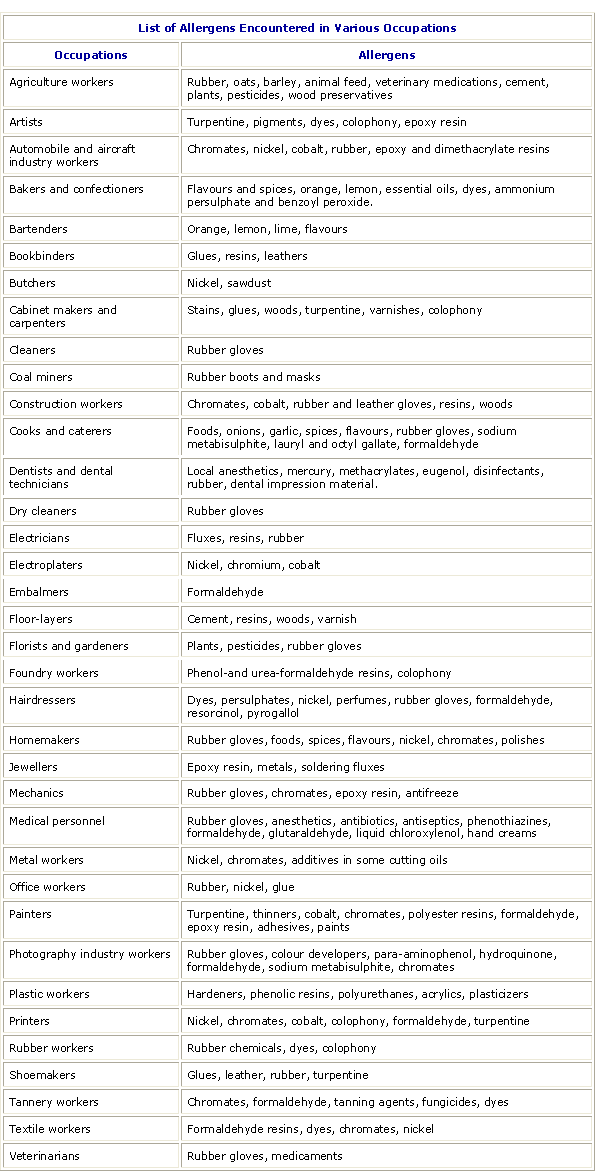Dermatitis - Symptoms, Causes, Treatments
Visit this
PICTURES OF RASHES PAGE
CONTACT DERMATITIS is a type of eczema. It is a dry skin condition that involves the inflammation of the skin. This is primarily caused by direct and usually repeated contact with an irritant (a substance that irritates the skin) or an allergen (a substance that leads to an allergic reaction). Often there is no reaction initially, but repeated exposure causes sensitization to the offending substance and then this skin problem occurs.
Two Principle Types
This skin problem can be divided into two principle types:
Irritant
Irritant is the most common form of contact dermatitis. The irritation or inflammation of the skin can resemble a burn and comes from contact with certain substances such as:
- acids and alkalis
- soaps and detergents
- solvents such as alcohol, acetone, xylene, paint thinner, etc.
- a variety of other chemicals
- sometimes plants such as hot peppers and tobacco
Allergen
Allergen dermatitis occurs because the affected individual has come in contact with a substance that he/she is allergic or very sensitive too. The symptoms range from a mild irritation and redness to a more serious condition of open sores. Examples of allergens that can trigger this condition are:
- a variety of plants including: poison ivy, poison oak, poison sumac
- chrome-plated objects or nickel containing objects (found in costume jewellery, belt buckles, wrist watches, zippers) and nickel sulfate
- various medications such as topical antibiotics
- rubber (gloves, condoms, etc.)
- cosmetics (eye shadow, nail polish, lipstick)
- clothing (various fabric types)
- detergents
- solvents
- adhesives
- perfumes and fragances
- sunscreens
- deodorants
- various other chemical substances: potassium dichromate (cements, household cleaners), formaldehyde, ethylenediame (dyes, medications), thiram (fungicides), paraphenylenediamine (permanent hair dyes, photographic chemicals).
A third type can be photo induced. UV light from the sun transforms substances that normally are okay, into irritants or allergens. The usual substances responsible for this are medications such as sulfa drugs, thiazides, and tetracycline. Please obey warnings (to stay out of the sun when taking this medication) that come with these drugs. Shaving lotions and sunscreens may also cause this problem.
Common Symptoms
- itching (mild to severe)
- inflammation, redness, or tenderness of the skin
- warmth in the skin in the affected area
- skin lesions (rash, pimple-like, blisters) that may ooze, drain, or crust over or lesions that become scaly, raw, or thickened
Treatments
Diagnosis of the problem is the first step and usually the most difficult. To determine if a particular substance is indeed causing contact dermatitis, a doctor often performs patch testing with the suspected substance. However, successful diagnosis is only possible with a lot of useful input from the patient. The patient must be vigilant in noticing what substances or products are causing the problem, when and how often the skin condition occurs, the severity of the problem, and the location on the body where it occurs. Usually the doctor or dermatologist is not around when a reaction occurs. Therefore, if the patient keeps good notes, this skin problem can be diagnosed quickly and treatment can be given to begin relieving the symptoms.
Immediate treatment involves washing off the irritant from the skin with plenty of water.
Long-term treatment is avoidance of any exposure (especially direct contact) to the problem causing substance. Use protective gloves or protective clothing if contact with the irritating substance is unavoidable. Usually, within two to six weeks the symptoms may disappear, but of course may reappear if contact with the offending substance occurs again. Avoid scratching the affected area as well as it tries to heal.
More specific treatments include:
- wet dressings with an astringent (e.g. aluminum acetate) and soothing anti-itch or drying lotions
- topical steroids such as hydrocortisone (ointments are used on dry or cracked skin and creams are used on inflamed skin or leaking lesions)
- systematic steroids (prednisone) – ingested medication used in more severe cases (greater than 20% body coverage) to relieve inflammation and other symptoms
- antihistamines such as diphenhydramine (Benadryl) to relieve inflammation, redness and itch
- emollients (urea cream or mineral oil) are used to moisturize dry skin to help soothe the dermatitis and reduce inflammation
- barrier creams (zinc oxide paste) for minor relief of skin irritations
Other Dermatitis Facts
- the hand version of this skin problem affects 2% of the population
- 20% of females are affected at least once in their lifetime
- fair-skinned redheads are the most vulnerable
- females are twice as likely as men to be affected
Contact dermatitis is the leading cause of workman’s compensation claims for dermatologic conditions. In fact, about 90% of such claims are for this skin condition. Therefore, it is evident that this is a serious occupational health and safety problem. Below is a list of allergens commonly encountered in various occupations that can lead to this skin problem (taken from Canadian Centre for Occupational Health and Safety).

With contact dermatitis there is always a chance of skin infections. Therefore, treat this dry skin problem seriously. Consult a doctor or dermatologist if symptoms are beyond minor irritation.
More dry skin information:
dry skin care | symptoms | causes | prevention | treatments | moisturizers | lotions | eczema | psoriasis | dermatitis
